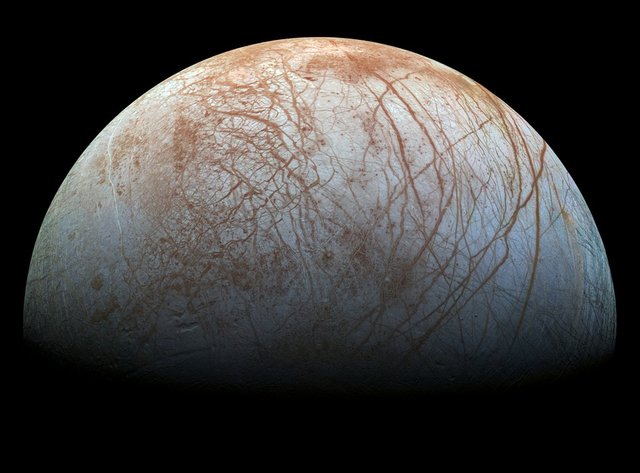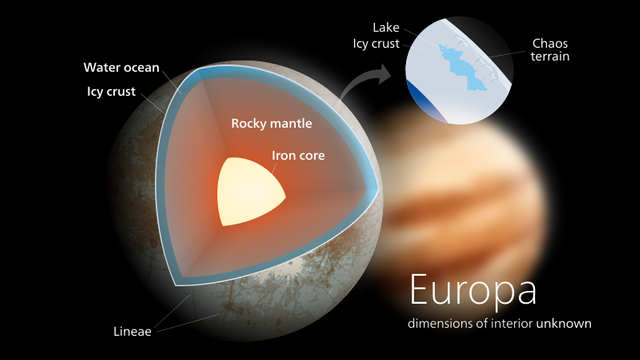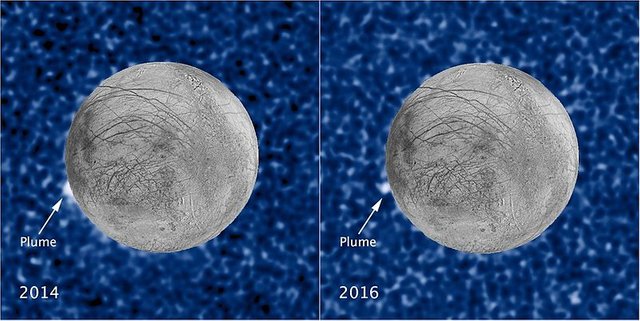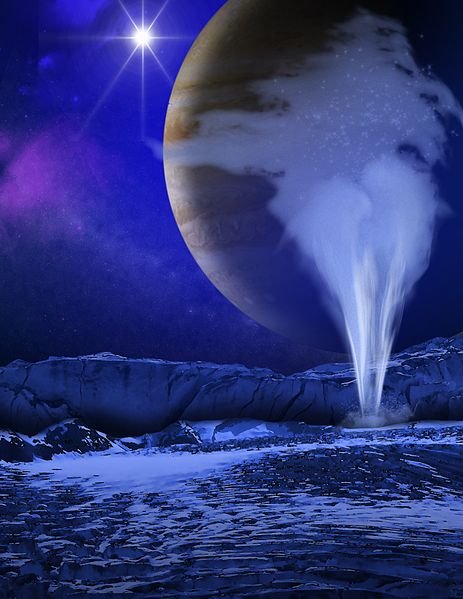What Does the Recent Discovery of Water Vapour Plumes on Jupiter's Moon - Europa, Mean?
In a recent post where I wrote about the possibility of extraterrestrial life elsewhere in the universe, the post was graced with the presence of @lemouth @dedicatedguy @alexdory and other members of the @steemstem community. We all discussed the possibility of life being somewhere else in the universe, either intelligent life or life at a microbial state, it was a satisfying open-minded conversation, with a lot of key points to learn from. The summary of the discussion was that the universe is old enough to have more than one planet with life, and also, the universe should probably have more than one planet with intelligent life.
And over last weekend, I got a Space.com notification of an article that seems to confirm the presence of water on the Galilean moon - Europa. Water vapour plumes have said to have been spotted by The Hubble Space Telescope, which also reports that this vapour plume is several hundred kilometres high; which possibly stems from the moon's subsurface global ocean. This is really a fascinating development as one thinks of the implications of this discovery. This is a giant step forward in fully understanding the morphological composition of Europa, and secondly, it will advance man’s quest to find alien life in other planetary bodies.
A Little Introduction to the Moon of the Moment - Europa
Europa is the smallest moon among the four Galilean moons, and it is the second closest to Jupiter. Jupiter II, as Europa is alternatively known as, is the smallest of the four moons orbiting their host star. Measured at 3121.6km, Jupiter II is smaller when compared with Earth’s moon that measures at 3,474 Km. The origin of the name Europe can be said to have been derived from the noblewoman of ancient mythology, Europa, a descent of the Phoenician civilization, who later become one of Zeus’s lover.
This moon can be morphologically characterized as possessing a shiny and smooth surface consisting of sheets of thick ice. The outer surface of Europa is made up of silicate rock, similar to that of the terrestrial planets and its core is believed to be made of iron-nickel. Europe is believed to possess an ocean of water beneath its thick icy surface, and despite its size, it is believed to have twice as much water in comparison to Earth. Lastly, the atmosphere of Europa is comprised of thin oxygen.
Exobiologists are very interested about Europa and are closely monitoring the recent developments, I believe they will be very interested in the analytical outcome of the water samples that can come out of this Icy world. Theorise have emerged stating that Europa could someday be able to support human life, because of the availability of a tenuous oxygen atmosphere. Even if that were possible, we still have to figure out a way around Jupiter’s dangerous radiation.
Recent Development
In October 1989, an unmanned spacecraft known as Galileo was launch to study Jupiter and the Galilean moons. In the late 1990’s the spacecraft explored Jupiter and its surrounding systems, making several flybys of Europa, gathering data with the use of its magnetometer and cameras. The spacecraft got really close to the surface of the moon, somewhere around 206 kilometres away from the surface of the satellite. It collected data such as the moon’s magnetic field strength, and plasma distribution. In times past, Europa has been believed to be an ocean of water beneath the moon’s icy surface. But there has never been any valid proof to validate these claims that the planet is a global underground ocean.
Over the course of last past decade, It was revealed that The Hubble Space Telescope (HST) which is owned by NASA, has been said to have also picked up direct images of the water vapour plumes of Europa. The build-up to this discovery all started with a team of astronomers in 2012 who were researching the relationship between Europa and Jupiter’s magnetic field, with the aid of the HTS. The result detected wave characteristics, as well as emissions that reflect water molecules break-up.
The data from both The Hubble Space Telescope and Galileo, have given an estimate of the width and height of this plume. Although, Galileo is said to have been the source of the most compelling data, due to the limited sensitivity of THS.
Now, What’s with Plumes?
The presence of a water vapour plume at Europa suggests many things, such as the possibility that this moon is, in fact, a global subsurface ocean mainly consisting of water. This vast water of this moon is said to be in direct contact with the satellite's rocky core which could give a set of interesting chemical reactions. Also, that the satellite has the ability to generates heat within its core. It is no secret that water is an important ingredient in the creation of life, and with the right amount of heat, there is bound to be the creation of several life forms. With the discovery of this plumes at Europa, this ticks the boxes of the possibilities of life in this Galilean moon.
And with the emergence of this plumes, it makes the job of future space missions so easy as they won’t have to break through several kilometres of ice to get water samples from the satellite’s massive water supply, the water content of the plumes will be as good as what’s obtainable in the water ocean, beneath the icy moon.
If the presence of the plumes is confirmed, then Europa will become the second moon in the Milky Way, that possesses this feature, second to the Saturn Moon - Enceladus. Europa is six times bigger than Enceladus, but many astronomers believe both moons have striking similarities, and with the emerges of the plumes on Europa, it just goes further to prove this fact. Both moons are closely watched by astronomers for the possibility of an alien life, and as a possible habitat for humans, something in the distant future, after the eventual demise of home - Earth.
What Happens Now?
NASA is already working on a new Jupiter-orbiting mission known as the “Europa Clipper”, this mission is scheduled to launch in the early 2020’s. The mission is said to entail about 40 to 45 flybys, that is if everything works out as planned. Also, over the course of the mission, the spacecraft will also make a comprehensive study of Europa’s atmosphere, it’s global ocean, and the satellite's ice shell. This will be in a bid to comprehensively better understand the moon’s ability to support life.
Part of the Europa Clipper mission is to scout and secure possible locations for lander missions that might be explored sometime in the future, this was a directive by Congress as given to the Space agency to workout in their plans. Officials at NASA said they hope the mission can actually have the spacecraft dive through one of the plumes, and if possible, collect fresh samples of the satellite's water.
Although data suggest that the production process of the plumes in Europa, should they exist, its characteristics may not possess a continuous nature, like that of Saturn’s Enceladus. Hence, the plumes occurrence maybe sporadic, this will make the drive-by sample mission, a little herculean.
Reference
YOUTUBE - Re-analysing Old Data Reveals New Evidence
Space.com - Plume on Jupiter’s Moon
ScienceMag - Water Vapour Plumes Erupt From Europa
YOUTUBE - Hubble Directly Images Possible Plumes on Europa





The top Space.com link leads to a dead web page. I guess you made a tiny typo there. The reference link in the bottom is working
Thanks for the observation @mathowl, you are right, there actually was a tiny typo in the reference link, the "J" in Jupiter was initially capitalized, and it was meant to be in small letters.
Thanks for this feedback. And keep up the amazing job.
That sounds very ambitious, I hope they can accomplish it and collect a lot of information about that place.
Europa does seem like a special place, especially for people that knows the "Space Odyssey" fiction story.
That's the exact same thing I said when I first heard about the plan, it sounded like a typical Tom Cruise idea. But if successful, it will be a major win for science and humanity.
Wonderful post @Ogbona. You keep dropping these amazing write- ups. Thanks for sharing
Thanks and the name is Agbona, not Ogbona.
Sorry for that mistake Agbona. I was typing fast
Noone is above typos, and thanks for commenting on my post!
What a revelation you made here @agbona.
Never knew there are four Galilean moons. I wonder if they are different from the popular moon we are all know?
@eurogee of @euronation community
Well, Moons are natural satellites know to orbit around planets, Earth has only one moon, whereas Jupiter has 67 known moons, and there are many other identified objects currently orbiting the gas giant that are currently undergoing classification, so that number is likely to increase.
Anyways, I am glad you find this post educative, stick around, I am currently writing on Saturn's moon - Enceladus, it promises to be a fascinating read.
✌️
What an insight shared, glad to add more to my knowledge box.
Well done!
Absolutely!
We learn every day, am so glad you find the post informative
Hope to see more of you.
Definitely!